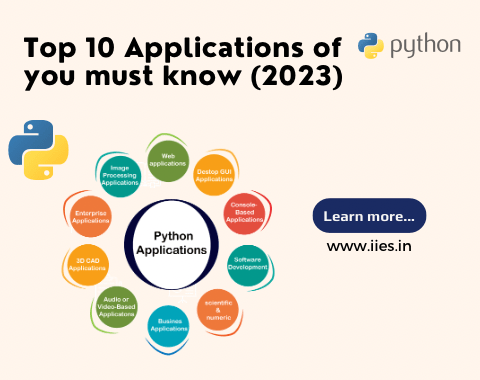
Python, with its versatility and strength, has seen a remarkable surge in popularity across multiple sectors. Its simplicity, readability, and robustness have made it the preferred programming language for developers. In this blog, we will delve into the top 10 applications of Python that are essential for you to know in 2023. These applications will not only astound you but also shed light on the transformative power of Python in various industries.
First and foremost, Python has found extensive use in web development. With frameworks like Django and Flask, developers can quickly build dynamic and scalable websites. Python’s ease of use and extensive library support make it an excellent choice for crafting web applications.
Additionally, Python’s data handling capabilities have made it indispensable in the field of data science. Pandas, NumPy, and SciPy are just a few of the powerful libraries that Python offers for data manipulation, analysis, and visualization. From data cleaning and preprocessing to complex machine learning algorithms, Python has become the go-to language for data scientists.
Python has revolutionized web development with its powerful frameworks like Django and Flask. These frameworks provide developers with a seamless environment to build web applications quickly and efficiently. Many popular websites, including Instagram, Pinterest, and Spotify, have been built using Python. For example, Instagram, a leading social media platform, showcases the power and scalability of Python in web development.
In the era of big data, Python has become the preferred language for data science and analytics. Its extensive libraries such as Pandas, NumPy, and Matplotlib offer a robust set of tools for data manipulation, statistical analysis, and data visualization. Python’s simplicity and versatility make it accessible to both beginners and experts in the field. As a result, Python has become a crucial tool in extracting valuable insights from massive datasets.
Python’s dominance in machine learning and artificial intelligence (AI) cannot be overstated. Libraries like TensorFlow, PyTorch, and scikit-learn provide a vast collection of tools and algorithms for building intelligent systems. Python’s applications in AI range from image recognition to natural language processing. For instance, self-driving cars, voice assistants like Siri, and recommendation systems all rely on Python’s capabilities. Its flexibility and scalability make Python a perfect fit for developing complex AI models.
Python has made significant contributions to scientific research and numeric computing. Libraries like SciPy and SymPy provide scientists and engineers with an extensive range of tools for scientific computing and symbolic mathematics. Researchers in fields like physics and engineering use Python to perform complex simulations and calculations. For example, scientists at CERN extensively used Python during the discovery of the Higgs boson, highlighting its significance in scientific breakthroughs.
Python’s simplicity and flexibility make it an excellent choice for automating routine tasks and scripting. It is extensively used in system administration and network programming, where repetitive tasks can be automated to save time and effort. Python provides libraries and tools for automating file operations, network tasks, and data processing. For instance, Python scripts can automate tasks such as data backups, file transfers, and server monitoring.
Python is increasingly gaining popularity in the game development industry, particularly for creating 2D games. The Pygame framework offers a user-friendly environment for developing games using Python. Popular games like Bejeweled 2 Deluxe, StarCraft: Brood War and Civilization IV have been developed using Python. The simplicity and versatility of Python make it an attractive choice for indie game developers and hobbyists.
Python’s versatility extends to the Internet of Things (IoT), where it serves a crucial role in connecting, controlling, and interacting with IoT devices. Python’s easy-to-understand syntax and extensive libraries make it an ideal choice for building IoT applications. From smart homes to industrial automation, Python finds its application in various IoT projects. For instance, Python can be used to control and monitor home appliances, collect sensor data, and analyze IoT device interactions.
Python is widely used in the field of cybersecurity due to its flexibility and extensive libraries. It is employed in penetration testing, vulnerability scanning, and forensic analysis. Security professionals rely on Python’s capabilities to develop scripts and tools for improving cybersecurity measures. For example, Python scripts can automate tasks like scanning network vulnerabilities, analyzing log files, and detecting malware. Python’s security features and architecture make it an ideal language for various security projects.
Python has found its way into building software applications that solve business problems. With frameworks like Flask, Python allows developers to create internal tools such as customer relationship management (CRM) systems, inventory management systems, and analytics dashboards. Python’s focus on rapid development and minimalist solutions makes it an attractive choice for businesses looking to create efficient and scalable applications.
Python’s simplicity and readability make it a popular language for teaching programming and computer science concepts. Many educational institutions and online platforms utilize Python as the primary language for teaching programming. Python’s extensive documentation, vast community support, and intuitive syntax make it accessible to beginners. Whether it is learning basic python programming concepts or delving into advanced algorithms, Python offers a smooth learning curve to students and aspiring developers.
Python’s growing popularity and versatility have contributed to its applications across various industries. From web development to data science, machine learning, and beyond, Python has proven to be a powerful language with a wide range of applications. The examples discussed in this blog highlight Python’s impact and potential in each domain. As a developer, exploring Python’s applications based on your interests and career goals can open up new opportunities and elevate your skills to the next level. Embrace the future of Python and witness its transformative influence in the technological landscape of 2023 and beyond.
Indian Institute of Embedded Systems – IIES